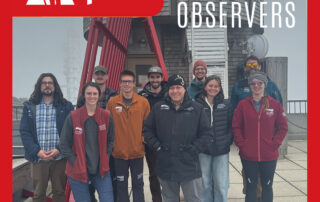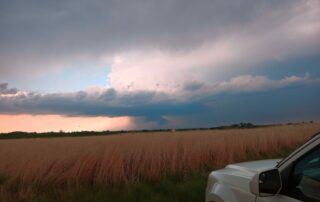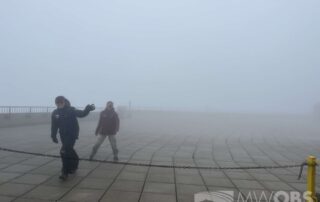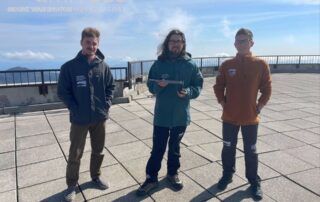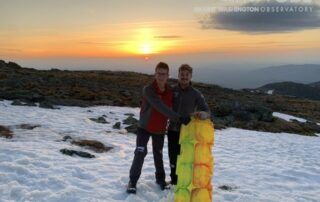Mount Washington Observatory Observer Blog
June 2024 By The Numbers
June 2024 By The Numbers By Ryan Knapp Alpine Flowers with Mt Adams and Madison in the background taken early June 2024. July has arrived, so it is a perfect time to look back and summarize June 2024 and the 2023/2024 snowfall season, which ended on June 30. If I were to use adjectives to summarize June 2024's weather conditions on the summit, they would be - warm, moist, and windy. To find out why, let's look back at some of the stats for June 2024: Our average temperature for June 2024 was 48.2°F (9°C), which is
Meet the MWOBS Seek the Peak Teams
Meet the MWOBS staff teams participating in this year's Seek the Peak! Every summer, representatives from our administrative office in North Conway, Weather Station on the summit of Mount Washington, and everywhere in between, join together to advocate for the many projects and initiatives happening across the organization while celebrating this special institution alongside the community that makes it all possible. Thank you to all who support this event every year, and please consider supporting one of the below Observatory teams as they go head to head in some (friendly) fundraising competition! MWOBS Weather
Living Life in the Clouds
Living Life in the Clouds By Maya Hartley Hi everyone! My name is Maya Hartley and I am the fourth intern for the MWOBS summer season, writing to tell you all about my experiences so far with my new life in the clouds— literally! Growing up in Newport, Rhode Island, with an offshore lobsterman for a father and a mother who worked for Naval Station Newport, weather was always the most prevalent topic in our household conversations. When I realized that it was possible for me to be one of the scientists that we watched on The Weather Channel
To the Plains: My First Storm Chase
To the Plains: My First Storm Chase By Francis Tarasiewicz The storm that produced a very wide area of violent rotation and the one that we had to quickly outrun. Like most other meteorologists, I went through a childhood weather geek phase prior to being a certified bachelors-degree-geek. A large part of my geek street cred came from the media I consumed growing up. It’s embarrassing to admit but my screen time as a kid was filled with the Weather Channel’s Storm Stories, Discovery Channel’s Storm Chasers and any number of natural disaster documentaries. I remember the
The First Severe Heat of the Year Sweeps Across the Midwest and Northeast
The First Severe Heat of the Year Sweeps Across the Midwest and Northeast By Alexis George New Englanders dragged fans and air conditioners out of their closets earlier this week as the first heat wave of the year gripped the Northeast. The hot and humid weather that arrived on Tuesday, June 18th, prompted officials to declare heat alerts as temperatures skyrocketed into the 90s across many locations. And the humidity only made it feel hotter, which caused the heat index to soar over 100 degrees in parts of the Northeast on Tuesday afternoon. We saw little relief from the
Starting Out Life at 6288 Feet
Starting Out Life at 6,288 Feet By George Mousmoules Hey everyone, I’m George Mousmoules and am very excited to be one of this year’s summer interns here at the Observatory! Though I was born in southern California, I have lived in southern New Hampshire for most of my life. Growing up, I would frequently vacation with my family throughout northern New England, and am no stranger to the White Mountains and the extreme weather they are known for. It was during one of these visits that I witnessed my first hailstorm, and ever since then I have had an
USFS WMNF Trailhead Steward Program with Volunteer Fawn Langerman
USFS WMNF Trailhead Steward Program By Fawn Langerman 2024 is my third year volunteering with the USFS WMNF Trailhead Steward program, and we are off to a great start! I was drawn to this volunteering as I have sometimes encountered poorly prepared hikers on the trails and wanted to help them: I think that one of the roots of this problem is the fact that the word “hike” is such a broad term. If you are from a city (like I am, originally), the word “hike” can often mean walking on a non-paved surface. Preparedness in a city is
Highlights of My First Week on the Summit
Highlights of My First Week on the Summit By Jacob Garside Good morning! I’m Jacob Garside, a new summer intern here at the Mount Washington Observatory. I grew up climbing Mt. Washington and the surrounding mountains and always dreamed of staying one night on the summit; now I get to spend almost fifty! I grew up in Henniker, New Hampshire, and was a rower at Concord Crew for almost five years. I’ve rowed at Youth Nationals, and have had the opportunity to row the Head of the Charles Regatta in Boston quite a few times. I am an avid
Guy Gosselin Remembered and Trustees Honored at 2024 Annual Meeting
A sunset in July on Mount Washington. Guy Gosselin Remembered and Trustees Honored at 2024 Annual Meeting By Drew Bush 2023 was a year of progress at Mount Washington Observatory. We made critical investments in educational programs, research partnerships, technology, and efforts to sustain the Observatory financially. Our partners, members, and supporters are the ones who made this possible. The energy in the room at McAuliffe-Shepard Discovery Center was palpable when our 2024 Annual Meeting convened with friends, Trustees, and members in attendance on June 1, 2024. Earlier in the day, the Board of Trustees approved two new positions
Meet Summer Intern Joshua Elms
Meet Summer Intern Joshua Elms By Joshua Elms Hi! I’m Joshua Elms, an intern working on the summit for Summer 2024. I just graduated with a Bachelor of Science in Data Science from Indiana University in Bloomington, Indiana, and this fall I’ll be back for my Master’s in Atmospheric Science at the same university. Indiana wasn’t where I grew up, though; I moved around the country a fair amount, living in California, Arizona, Hawaii, and Virginia before going to Indiana for college. I saw precious little extreme weather while growing up, but Arizona’s haboobs (dust storms) stuck with me.
Search with Text


